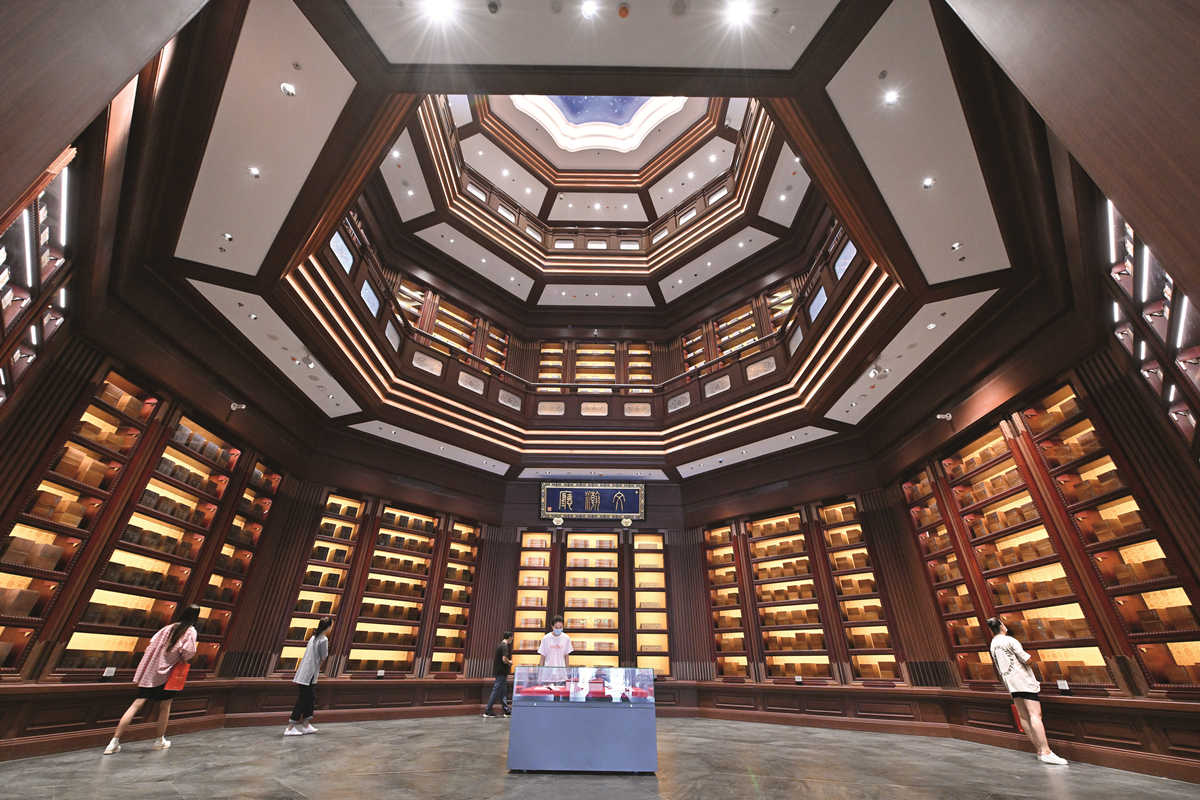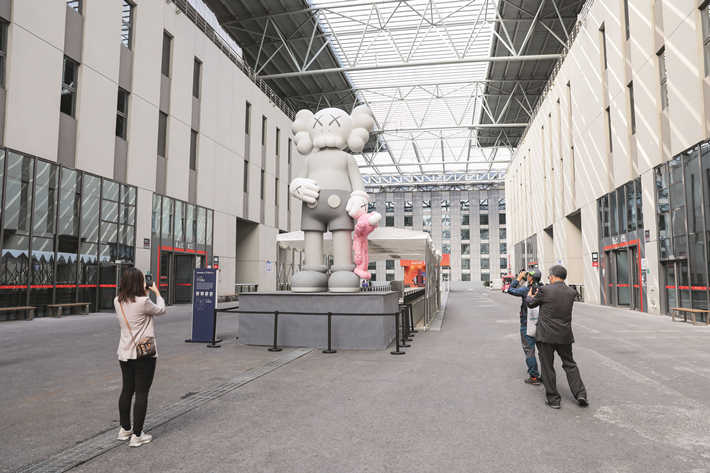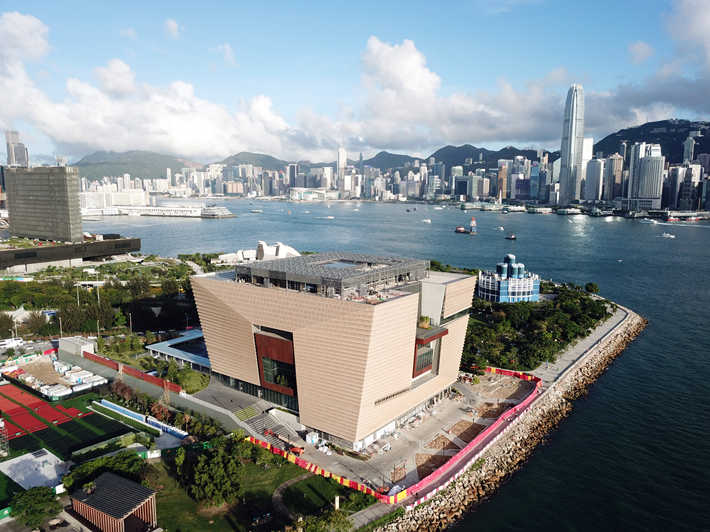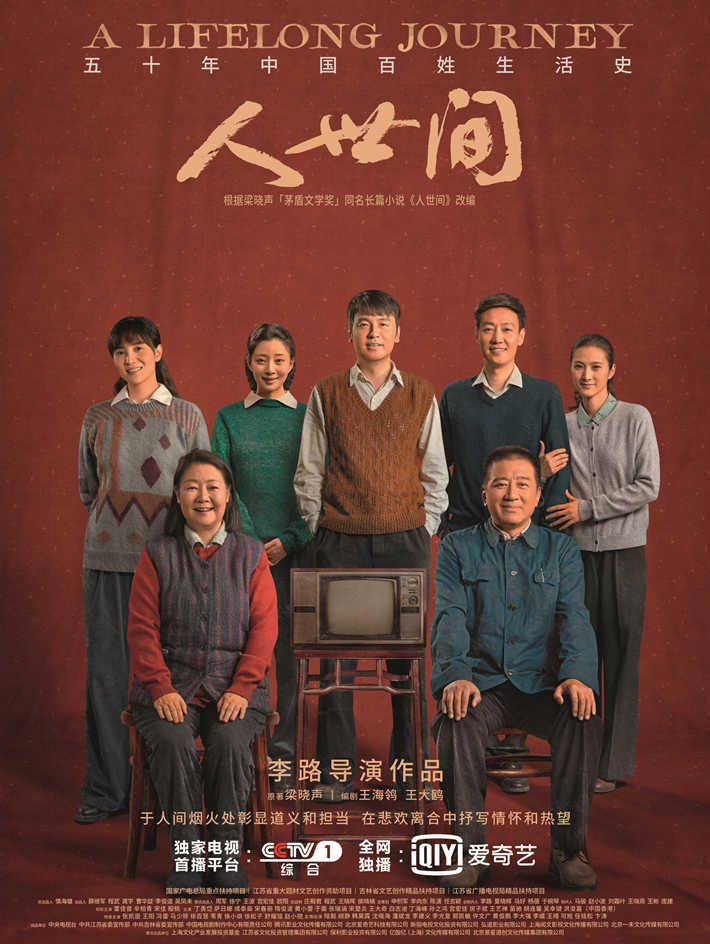Cultural Connection Comes Full Circle

In 2022, various Chinese cultural items repeatedly shot to popularity across a wide range of realms: The TV series A Lifelong Journey created a sensation despite depicting the realistic lives of ordinary people. China’s animation exploded with new expressions of traditional aesthetics after 100 years of development. The salvage operation of the Yangtze River Estuary No. 2 ancient vessel marked a new breakthrough in underwater archeology. China’s traditional tea-making ritual was added to the intangible cultural heritage list of the United Nations Educational, Scientific, and Cultural Organization (UNESCO). This year, Chinese civilization will continue to welcome exchange and mutual learning with other civilizations through exhibitions of cultural relics and artworks, cross-border transactions, and digital collections.
Seed Bank of Chinese Culture
On July 23, 2022, China National Archives of Publications and Culture opened in Beijing. A national pool of bibliology resources and a seed bank of Chinese culture, it consists of the headquarters in Beijing and three branches in Xi’an, Hangzhou, and Guangzhou, respectively. Together, they form a system to inherit and preserve national bibliology resources.
The National Archives of Publications and Culture ensures the permanent security of Chinese publications and offers a wide array of bibliology resources with imprints of Chinese civilization from all countries. A comprehensive cultural venue integrating multiple functions, the institution is consistent with the latest international concept of GLAM (Galleries, Libraries, Archives, and Museums).

Popular Rural Culture
In recent years, “local culture fever” has emerged in many places across China. Many traditional villages with rich historical legacies and regional cultural landscapes have become popular again. People visit traditional villages to experience rural life and soak up the timeless culture they radiate. Largely thanks to its ability to preserve cultural nostalgia, rural culture has become a mainstream trend in Chinese society. The prosperity of rural culture drives and manifests rural revitalization.

Hougou Village is located in eastern Yuci District, Jinzhong City, Shanxi Province.It preserves the millennia-old spiritual beliefs, production methods, and living conditions of the Han culture in northern China, becoming a “living fossil” of northern folk culture. Here, villagers and tourists watch a dramatic performance on a traditional theater stage in Hougou Village. The theater troupe’s repertoire from the 1950s has been preserved to this day. (Photo courtesy of the Party committee of Dongzhao Township)
100 Years of Chinese Animation
The year 2022 marked the centenary of the birth of Chinese animation. Throughout the past century, Chinese animators have integrated traditional Chinese cultural elements such as ink painting, paper-cutting, and puppets into animation. Many animated works with Chinese characteristics have emerged such as Havoc in Heaven and Ne Zha Shaking the Seas. The Eastern charm of classic works remains engraved in the memories of generations of audiences and continues to influence subsequent creations.
Today, Chinese animation, once marginalized by a massive influx of imported animated works, is set to welcome a revival of sorts. Through re-embracing traditional Chinese culture, it has been endowed with new interpretations and new expressions adapted to contemporary viewers.

A still from the Chinese animated film New Gods: Yang Jian. The movie offered a new interpretation of the ancient Chinese mythological figure Yang Jian. The film was shortlisted for the 95th Oscar for Best Animated Feature Film.
New Breakthroughs in Underwater Archeology
A merchant ship dating back to Emperor Tongzhi’s reign of the Qing Dynasty (1644-1911), Changjiangkou No. 2 sank more than 150 years ago. Loaded with rich cultural relics, it is now recognized as one of the largest and best-preserved ancient wooden shipwrecks ever found in China and even the world. The salvage and migration project of the ancient ship is the world’s first attempt to carry out archaeological excavation, overall migration, cultural relics protection, and museum construction simultaneously. It is fostering integration of cultural relics protection and technological innovation, leading to a historic breakthrough for China’s underwater archeology.

Utilizing the world’s first curved beam non-contact overall migration technology for cultural relics, the ancient ship Yangtze River Estuary No. 2 is successfully salvaged,November 21, 2022. (Photo by Jin Liwang/Xinhua)
Traditional Chinese Tea Rituals
On November 29, 2022, the item “Traditional tea processing techniques and associated social practices in China” was inscribed on the UNESCO Representative List of the Intangible Cultural Heritage of Humanity. This marks China’s 43rd item on the intangible cultural heritage list and padded its lead as the country with the most inclusions.
This heritage has been passed down across generations, forming a complete knowledge system with extensive social practices, mature traditional skills, and a wide variety of handmade products. It reflects Chinese values of modesty, harmony, courtesy, and respect. The practices promoted exchanges and mutual learning among civilizations along the Silk Road and played an important role in the sustainable development of human society.

The item “Traditional tea processing techniques and associated social practices in China” is examined during the 17th session of the UNESCO Intergovernmental Committee for the Safeguarding of the Intangible Cultural Heritage in Rabat, Morocco, November 29, 2022. (Photo by Xu Supei/Xinhua)
Digital Collection
In recent years, museums have been delving into digital collections, either by developing their own or joining hands with leading NFT platforms. Almost every institution has sought to create a digital rendering of its most prized holding.
Digital collections are made with the help of blockchain technology, which can generate unique digital certificates for each and every piece of works. With protected digital copyrights, digital works can be distributed, purchased, collected, or traded. The popularity of digital collections in museums has narrowed the distance between ancient cultural relics and young people, injecting new life into cultural heritage.

NFT digital works exhibited at Shougang Industrial Park, one of two venues of the China International Fair for Trade in Services, in Beijing, September 1, 2022. (Photo from IC)
Cross-border Transaction of Cultural Relics
During the fifth China International Import Expo (CIIE) from November 5 to 10, 2022, purchase intents were reached for 37 cultural relics and artworks brokered by nine overseas exhibitors including Christie’s, Sotheby’s, and Phillips, with a total turnover of 490 million yuan (US$70 million).
In recent years, Shanghai, Beijing, Hainan, and other Chinese cities and provinces have built international trading centers for cultural relics and artworks, pushing China’s cultural relics and art market into increasing maturity, with cross-border transactions in this field becoming more frequent. As a result, the internationalization of the Chinese cultural relics and art market is accelerating. These factors will play a major role in promoting two-way exchange between Chinese and international art markets and nurturing sound development of Chinese and global cultural industries.

Visitors take photos of the sculpture “SHARE” by well-known American artist Brian Donnelly, stylized as KAWS, at the consumer goods exhibition area of the fifth China International Import Expo (CIIE) in Shanghai, November 8, 2022. The five-meter-tall sculpture was the largest single exhibit at this CIIE. (Photo from IC)
Hong Kong Palace Museum
The Hong Kong Palace Museum is a creative combination of the splendid traditional Chinese culture represented by the Forbidden City and modern and international Hong Kong. It reflects a closer connection between Hong Kong and the Chinese mainland. Today, the museum has become a window for the dissemination of Chinese culture and a new cultural landmark. It is also playing a pivotal role in enhancing national historical and cultural identity, promoting exchange and mutual learning among civilizations, and expanding the influence of Chinese culture.

The Hong Kong Palace Museum is surrounded by the sea on three sides.Its main structure is a 7-story building.The museum officially opened to thepublic on July 3, 2022. More than 530,000 people visited within four months. (Photo by Li Gang/Xinhua)
Protection of Geological Heritage
On October 26, 2022, the International Union of Geological Sciences (IUGS) released the list of the first 100 IUGS geological heritage sites in the world. Seven Chinese geological heritage sites, including the “Golden Nails” geological section in Zhejiang Province and the karst stone forest in Yunnan, made the list. Geological heritage sites listed by IUGS are key areas with geological relics or processes of international significance. They can be used as global benchmarks for geological studies or regarded as sites of great significance in the history of geoscience. Recognition by IUGS shows that a geological heritage site has extraordinary value for international geoscience. It also means that the site has been effectively protected.

The Yunnan Stone Forest formed 270 million years ago. With various types of karst landforms such as oddly shaped rock formations, caves, lakes, and waterfalls, the stone forest in Yunnan is one of the most typical and diversified karst plateau ecosystems in the world. (Photo from CFB)
70th Anniversary of Beijing People’s Art Theater
June 12, 2022, marks the 70th anniversary of the founding of Beijing People’s Art Theater. A globally renowned cultural institution, the theater has been committed to telling vivid stories of China with distinctive Chinese style and characteristics for 70 years.
The 70-year history of Beijing People’s Art Theater is one of persistent exploration and experimentation in Chinese drama. It is also a history of continuous absorption and innovative adaptation of foreign plays and their performance methods, and a history of cultural exchange through the overseas distribution of Chinese theatrical arts. As the most prestigious dramatic theater in China, Beijing People’s Art Theater needs to continue to explore and create a more national and contemporary aesthetic system for Chinese drama to optimize its role as an important platform for international cultural exchange and showcasing the charm of Chinese civilization in the new era.

A scene from the performance titled “Salute to Drama—In Celebration of the 70th Anniversary of the Founding of Beijing People’s Art Theater,” June 11, 2022. Beijing People’s Art Theater organized a series of activities starting June 5 that year, to celebrate the 70th anniversary of its establishment.Through various online and offline channels, theater lovers interfaced with dramas to celebrate the 70th birthday of the theater. (Photo by Li Chunguang)
“Queen of Martial Arts” Returns
In 2022, Zhang Weili, a Chinese professional mixed martial arts athlete and Asia’s first Ultimate Fighting Championship (UFC) champion, reclaimed the women’s strawweight title within a year.
In August 2019, Zhang defeated Brazil’s Jessica Andrade in Shenzhen, China, to become the first Asian UFC champion. She successfully defended the title in 2020. But later in 2021, she lost the belt after two losses to American athlete Rose Namajuas. After more than a year away from the competition, she reclaimed the gold belt in November 2022 and became the third fighter in the world to reclaim the women’s strawweight championship.

Chinese athlete Zhang Weili defeats Carla Esparza via a second-round knockout at UFC 281 in New York,returning to the top of the women’s strawweight division, November 12, 2022. (Photo by Guo Ke/Xinhua)
Chinese TV Dramas Going Overseas
In recent years, Chinese TV dramas have accelerated their pace of “going global.” Disney purchased the overseas distribution rights for the Chinese TV series A Lifelong Journey within a month after it began filming. High-quality realistic dramas are receiving wide attention from overseas markets, sparking an emerging trend of Chinese TV dramas “going overseas.” China’s first domestically produced report on the international distribution of such dramas revealed that those which have successfully “gone overseas” tend to feature contemporary realistic stories instead of the more traditional content seen in historical dramas and kung fu dramas.

Poster for A Lifelong Journey. The TV drama reached a primetime rating not recorded by CCTV-1 in the past eight years. Its premiere run drew a total of 371 million viewers.
Woman Power in Film
On November 12, 2022, the 35th Golden Rooster Awards were presented in Xiamen, Fujian Province. Shao Yihui, a 31-year-old female director and screenwriter, won the award for best screenplay for her debut B for Busy.
In recent years, young female Chinese directors have sprung up like bamboo shoots after a spring rain. Their films have performed well in box office and artistic value alike. According to preliminary statistics, nearly 50 female directors in China have created more than 30 films with box office earnings of more than 100 million yuan (US$14 million) in the past 20 years—a testament to the strong market influence of female directors. The achievements of these female directors evidence the overall rise of woman power in the film industry, and the influx of female directors has exerted a subtle influence on the structure of the film circle.

A still from B for Busy, the debut film of Chinese female director Shao Yihui, born in the 1990s. Three actresses in their 40s and 50s took the bulk of the screen time in this film. B for Busy was highly acclaimed for expressing true-to-life feminine discourse, a trend of the times.